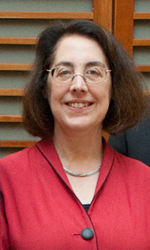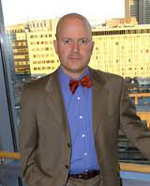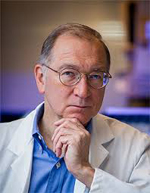
Glass crystals with thread-like filaments floating inside sit in the offices of two prominent immunologists. The clear blocks encase models of the structure of PD-1/PD-L1, a receptor-ligand pair that rides on the surface of cells, ready to rein in the immune system after its work attacking invaders is done.
PD-1 looms large in the growing field of cancer immunotherapy, which is why one model appears on Gordon Freeman’s desk in the Dana-Farber Cancer Institute and the other in Arlene Sharpe’s office at Harvard Medical School.
Their basic science discoveries about how cancer cells hijack PD-1 to turn off the immune system are being translated into therapies that they hope and believe can change cancer treatment.
After 15 years, drugs developed by several pharmaceutical companies based on the scientists’ work are awaiting approval by the U.S. Food and Drug Administration.
“It’s coming,” Freeman, HMS associate professor of medicine at Dana-Farber, said this summer, anticipating FDA action.
On Sept. 4 the FDA granted accelerated approval to one of these drugs, pembrolizumab, for treatment of patients with advanced melanoma.
Marketed by Merck, it is the first PD-1 inhibitor approved for use in the United States. Another anti-PD-1 antibody, Nivolumab from Bristol-Myers Squibb and Ono Pharmaceutical, was approved in Japan last month.

Sharpe, the George Fabyan Professor of Comparative Pathology in the Department of Microbiology and Immunobiology at HMS, takes the longer view. “This is creating a whole new era in cancer therapy,” she said.
For more than a hundred years, medicine has been trying to muster the immune system to combat cancer the same way it fights infections: activate the troops to recognize and repel invaders.
Lately, scientists have been taking another tack. Realizing that cancer has turned off the immune response, they have been finding ways to release the brakes that keep the immune system from clearing cancer cells away.
Much of this cancer immunology research has been done at HMS, from the early identification of one of those brakes to later discoveries about how they work.
PD-1, CTLA-4 and TIM-3 are three of many proteins acting as receptors on the surface of T cells. They serve as immune checkpoints, and when they bind to their ligands on the surface of other cells, they inhibit T cell responses. Antibody therapies work by blocking this binding process, thereby unleashing the T cells to attack tumor cells.
Stephen Hodi, HMS associate professor of medicine at Brigham and Women’s Hospital and Dana-Farber, was there at the beginning. His mentor was Glenn Dranoff, HMS professor of medicine at Brigham and Women’s and Dana-Farber.
Dranoff and Hodi discovered that their tumor cell vaccine worked better when combined with an antibody that blocked CTLA-4, developed by Jim Allison while at the University of California at Berkeley. This led them to the finding that CTLA-4 was a key inhibitor of tumor immunity.
In clinical trials, a drug based on their CTLA-4 work helped some patients with metastatic melanoma live longer, as their tumors melted away. This was the first conclusive work in humans showing that taking the brakes off the immune system could help cancer patients.
Later approved as the drug ipilimumab, this anti-CTLA-4 antibody was the field’s first success story in cancer patients who had few other therapeutic options after the tumor had spread. But the therapy came with challenging side effects. Unleashing the immune system allows it to fight cancer, but it also ramps up inflammation in alarming ways. Sharpe had earlier proved how.
Mice engineered to lack the gene that produces CTLA-4 died because their immune systems went wild, clearly showing—by its absence—the power of CTLA-4 as a dominant inhibitor of runaway immune responses. It turns out that CTLA-4 is one of the most important molecules that keep the immune system in a state of tolerance.
“At this point, I’ve decided that microbes and tumors are the smartest immunologists because they’ve stolen the tolerance-inducing or inhibitory pathways that are the most important, using them to evade immune eradication,” Sharpe said. “A tumor is constantly evolving, so it’s able to come up with multiple strategies.”
So far, her lab and others have identified more than 10 checkpoints that are active on the surface of immune cells and can be used by tumors to turn off the immune response that should be fighting cancer. One theory holds that these immune cells are suffering from exhaustion, weakened by the constant drain of chronic inflammation or inhibition by cancer cells. Tumors take advantage of this exhausted state, and grow unfettered after they bind to receptors such as PD-1 and CTLA-4 and block the immune response.
Ana Anderson, HMS assistant professor of neurology at Brigham and Women’s, working together with her mentor Vijay Kuchroo, the Samuel L. Wasserstrom Professor of Neurology at Brigham and Women’s and HMS, identified TIM-3 as another key regulator of immune cell function in cancer. She calls ipilimumab a boon for cancer immunotherapy and is hopeful about drugs aimed at PD-1, but sees opportunities in still other avenues for controlling tumor growth.
“We are getting responses, but we can do better,” she said at a recent symposium presented by the Evergrande Center for Immunologic Diseases. “It’s important to target other checkpoints.”

Keith Flaherty, HMS associate professor of medicine at Massachusetts General Hospital, believes drugs that unleash the immune system are wonderful when they work but inadequate because they work for so few patients. Two out of three patients receiving ipilimumab suffer unintended immune system activation—inflammation in the gut, on the skin or in thyroid, pituitary or adrenal glands—compared to the 1 in 10 who are helped by the therapy.
“That explains why ipilimumab was an advance but not one that made ripples in other cancers,” Flaherty said.
Then, in 2010, came experimental drugs to block PD-1. Antibodies directed against PD-1 had a much higher success rate, working in 40 percent of late-stage melanoma patients with a much lower rate of troubling autoimmune, or self-attacking, consequences.
“Forty percent is monumental compared to 10 percent,” Flaherty said. “The early and intermediate likelihood of benefit is clearly higher. For the long-term? We are developing that story year by year now.”
The anti-PD-1 therapies appear to durably reverse cancer’s escape from immune recognition not only in melanoma, but also in other cancer types, such as lung, bladder, kidney, and Hodgkin lymphoma cancers, albeit to lesser degrees. Seven pharmaceutical companies are testing drugs in clinical trials, thanks to a decision made by Sharpe and Freeman to license the intellectual property behind their discoveries widely, allowing many labs to attack the problem.
“Arlene is quite heroic in this regard,” Flaherty said. “She and Gordon held some of the therapeutic patents around PD-1, and Harvard and Dana-Farber nonexclusively licensed the intellectual property so all these efforts could multiply. It unleashed a bunch of therapeutic scientists on the problem so people could start engineering different antibodies. Some have worked and some have not, so this is a real blessing.”
 However promising these anti-PD-1 therapies may be, they may not be enough. TIM-3 antibodies might have advantages over PD-1, which has advantages over CTLA-4. Scientists are betting on combinations of these immunologic kinds of drugs, which then could be doubled up with drugs that target molecular pathways important in cancer development, such as BRAF and MEK inhibitors.
However promising these anti-PD-1 therapies may be, they may not be enough. TIM-3 antibodies might have advantages over PD-1, which has advantages over CTLA-4. Scientists are betting on combinations of these immunologic kinds of drugs, which then could be doubled up with drugs that target molecular pathways important in cancer development, such as BRAF and MEK inhibitors.
Each agent alone can have powerful effects, but tumors soon find ways around a single agent. Like HIV treatment, where a cocktail of drugs has turned that infection into a chronic illness, combinations of drugs to fight cancer offer more hope than single approaches alone.
“We need multiple drugs at once,” Flaherty said. “We and others have built up a portfolio of early clinical trials combining BRAF and PD-1 inhibitors, hoping the BRAF inhibitor will lower the force field and the immune therapies will work even better than they could otherwise.”
As an immunologist, Freeman says understanding CTLA-4 was a scientific turning point, while later work on PD-1 was a watershed moment for pharmaceutical development.
“It’s amazing,” he said about PD-1 therapies. “The PD-1 pathway started 15 years ago as a basic lab discovery and has really taken off. We’ve cured cancer 50 ways in mice but PD-1 is what works well in people.”
The Cancer Research Institute recently selected Sharpe and Freeman, along with Tasuku Honjo and Lieping Chen, to receive the 2014 William B. Coley Award for Distinguished Research for their pioneering work on the PD-1 pathway.
As an oncologist, Hodi sees progress in the exam room today while hoping for better therapies to come tomorrow.
“Even for those of us who were the biggest cheerleaders a few years ago, it’s hard to imagine that this field has moved as fast as it has,” Hodi said.


